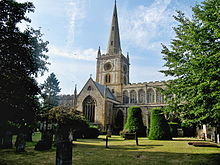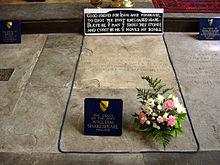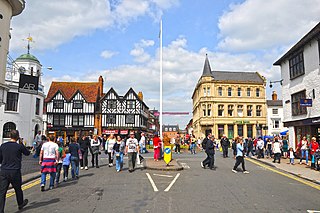
Stratford-upon-Avon, commonly known as just Stratford, is a market town and civil parish in the Stratford-on-Avon district, in the county of Warwickshire, in the West Midlands region of England. It is situated on the River Avon, 91 miles (146 km) north-west of London, 22 miles (35 km) south-east of Birmingham and 8 miles (13 km) south-west of Warwick. The town is the southernmost point of the Arden area on the edge of the Cotswolds. In the 2021 census Stratford had a population of 30,495.

John Shakespeare was an English businessman and politician who was the father of William Shakespeare. Active in Stratford-upon-Avon, he was a glover and whittawer by trade. Shakespeare was elected to several municipal offices, serving as an alderman and culminating in a term as bailiff, the chief magistrate of the town council, and mayor of Stratford in 1568, before he fell on hard times for reasons unknown. His fortunes later revived and he was granted a coat of arms five years before his death, probably at the instigation and expense of his son, the actor and playwright.

Sir Hugh Clopton was a Lord Mayor of London, a member of the Worshipful Company of Mercers and a benefactor of his home town of Stratford-upon-Avon in Warwickshire.

Anne Hathaway was the wife of William Shakespeare, an English poet, playwright and actor. They were married in 1582, when Hathaway was 26 years old and Shakespeare was 18. She outlived her husband by seven years. Very little is known about her life beyond a few references in legal documents. Her personality and relationship to Shakespeare have been the subject of much speculation by many historians and writers.

William Shakespeare was an actor, playwright, poet, and theatre entrepreneur in London during the late Elizabethan and early Jacobean eras. He was baptised on 26 April 1564 in Stratford-upon-Avon in Warwickshire, England, in the Holy Trinity Church. At the age of 18, he married Anne Hathaway, with whom he had three children. He died in his home town of Stratford on 23 April 1616, aged 52.

The Grammar School of King Edward VI at Stratford-upon-Avon is a grammar school and academy in Stratford-upon-Avon, Warwickshire, England, traditionally for boys only. However, since September 2013 the school has admitted girls into the Sixth Form. It is almost certain that William Shakespeare attended this school, leading to the school widely being described as "Shakespeare's School".

Susanna Hall was the oldest child of William Shakespeare and Anne Hathaway and the older sister of twins Judith and Hamnet Shakespeare. Susanna married John Hall, a local physician, in 1607. They had one daughter, Elizabeth, in 1608. Elizabeth married Thomas Nash, son of Anthony Nash on 22 April 1626 at Holy Trinity Church, Stratford-upon-Avon.

Temple Grafton is a village and civil parish in the Stratford-on-Avon district of Warwickshire, England, situated about 4 miles (6.4 km) east of Alcester and 14 miles (23 km) west of the county town of Warwick. The place name is misleading, the Knights Templar never having any association with the place but owing to a naming error made in the time of Henry VIII the mistake has been perpetuated. During the reign of Richard I the estate in fact belonged to the Knights Hospitaller. During the reign of Edward III in 1347 the village was recorded as Grafton Superior while neighbouring Ardens Grafton was named Inferior.
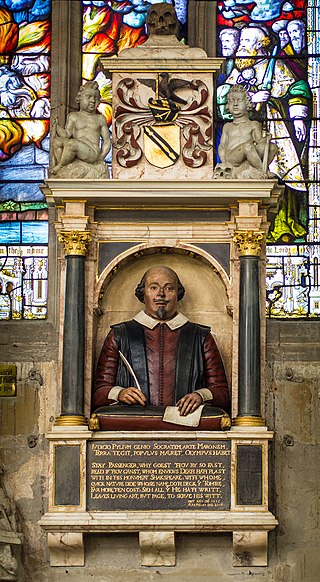
The Shakespeare funerary monument is a memorial to William Shakespeare located inside Holy Trinity Church at Stratford-upon-Avon in Warwickshire, the church in which Shakespeare was baptised and where he was buried in the chancel two days after his death.

Judith Quiney, née Shakespeare, was the younger daughter of William Shakespeare and Anne Hathaway and the fraternal twin of their only son Hamnet Shakespeare. She married Thomas Quiney, a vintner of Stratford-upon-Avon. The circumstances of the marriage, including Quiney's misconduct, may have prompted the rewriting of Shakespeare's will. Thomas was struck out, while Judith's inheritance was attached with provisions to safeguard it from her husband. The bulk of Shakespeare's estate was left, in an elaborate fee tail, to his elder daughter Susanna and her male heirs.
Thomas Quiney was the husband of William Shakespeare's daughter Judith Shakespeare, and a vintner and tobacconist in Stratford-upon-Avon. Quiney held several municipal offices in the corporation of Stratford-upon-Avon, the highest being chamberlain in 1621 and 1622, but was also fined for various minor offences.

Elizabeth, Lady Bernard was the granddaughter of the English poet, playwright and actor William Shakespeare. Despite two marriages, she had no children, and was his last surviving descendant.

Thomas Nash was the first husband of William Shakespeare's granddaughter Elizabeth Barnard. He lived most of his life in Stratford-upon-Avon, and was the dominant male figure amongst Shakespeare's senior family line after the death of Dr. John Hall, Shakespeare's son-in-law, in 1635.

William Shakespeare has been commemorated in a number of different statues and memorials around the world, notably his funerary monument in Stratford-upon-Avon ; a statue in Poets' Corner in Westminster Abbey, London, designed by William Kent and executed by Peter Scheemakers (1740); and a statue in New York's Central Park by John Quincy Adams Ward (1872).
John Ernest Cook was an Anglo-American organist, composer and church musician.
Gilbert Shakespeare was a 16th-/17th-century English haberdasher, and a younger brother of playwright and poet William Shakespeare. His name is found in local records of Stratford-upon-Avon and London.

William Clopton (1538–1592) was a member of the English gentry who inherited New Place in Stratford upon Avon, and in 1563 sold it to William Bott.

William Shakespeare's last will and testament was signed on 25 March 1616, just under a month before his death. The document has been studied for details of his personal life, for his opinions, and for his attitudes towards his two daughters, Susanna and Judith, and their respective husbands, John Hall and Thomas Quiney. The best-known passage of the will is the bequest to the wife of his "second best bed". The significance of this phrase is not certain.

Stratford's Historic Spine is the name given to a route in Stratford-upon-Avon along which many of the town's most important and historic buildings are sited, with many of the buildings connected to William Shakespeare. The Historic Spine was once the main route from the town centre to the parish church. It begins in Henley Street at Shakespeare's Birthplace and finishes in Old Town at The Holy Trinity Church and has buildings from the 14th up to the 20th centuries.
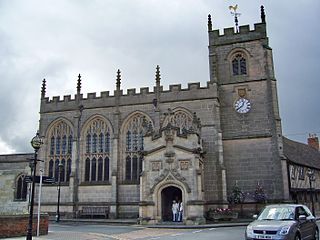
The Guild Chapel of the Holy Cross, Stratford-upon-Avon, Warwickshire is a chapel of 13th century origins. Founded by the Guild of the Holy Cross before 1269, it passed into the control of the town corporation in 1553, when the Guild was suppressed by Edward VI. The chapel stands on Church Street, opposite the site of William Shakespeare's home, New Place, and has historic connections to Shakespeare's family. The chapel was gifted an extensive series of wall-paintings by Hugh Clopton, an earlier owner of New Place, and John Shakespeare, Shakespeare's father, undertook their defacement in the later 1500s. The paintings have recently been conserved.
